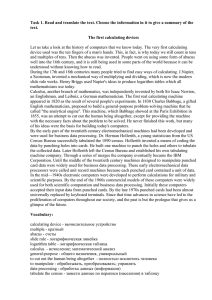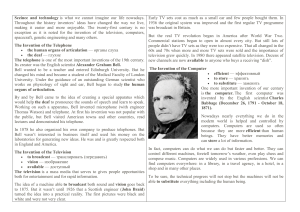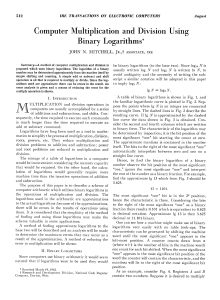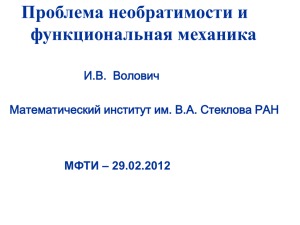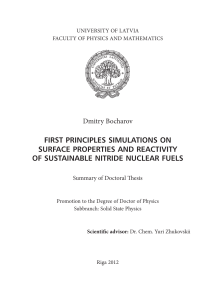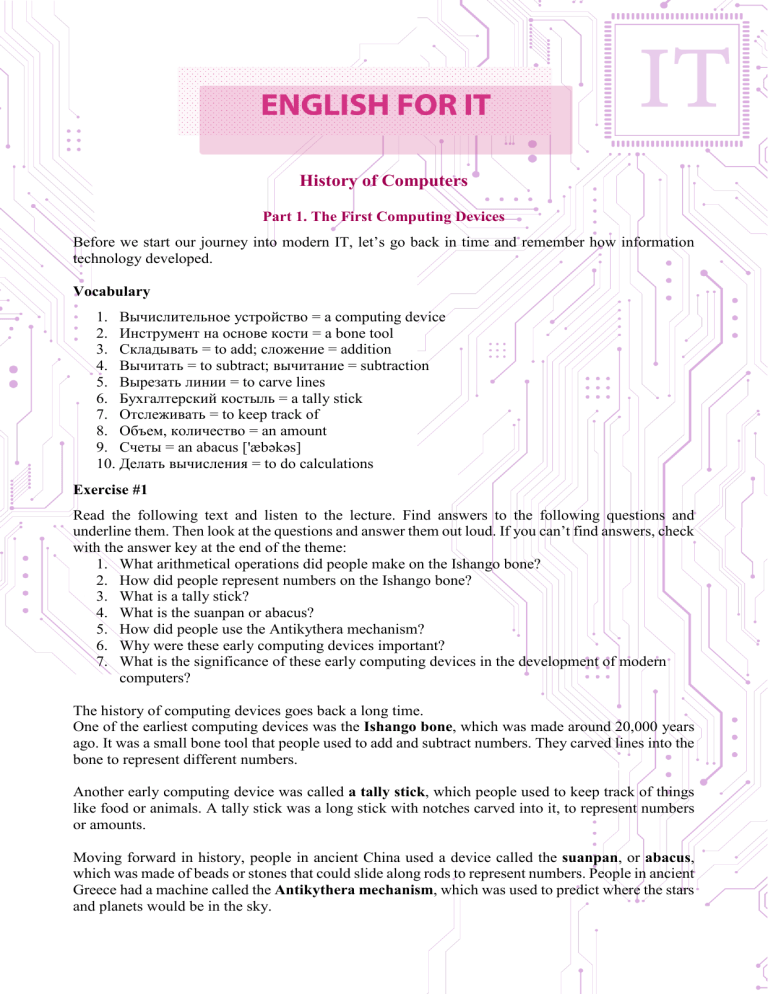
History of Computers Part 1. The First Computing Devices Before we start our journey into modern IT, let’s go back in time and remember how information technology developed. Vocabulary 1. Вычислительное устройство = a computing device 2. Инструмент на основе кости = а bone tool 3. Складывать = to add; сложение = addition 4. Вычитать = to subtract; вычитание = subtraction 5. Вырезать линии = to carve lines 6. Бухгалтерский костыль = a tally stick 7. Отслеживать = to keep track of 8. Объем, количество = an amount 9. Счеты = an abacus ['æbəkəs] 10. Делать вычисления = to do calculations Exercise #1 Read the following text and listen to the lecture. Find answers to the following questions and underline them. Then look at the questions and answer them out loud. If you can’t find answers, check with the answer key at the end of the theme: 1. What arithmetical operations did people make on the Ishango bone? 2. How did people represent numbers on the Ishango bone? 3. What is a tally stick? 4. What is the suanpan or abacus? 5. How did people use the Antikythera mechanism? 6. Why were these early computing devices important? 7. What is the significance of these early computing devices in the development of modern computers? The history of computing devices goes back a long time. One of the earliest computing devices was the Ishango bone, which was made around 20,000 years ago. It was a small bone tool that people used to add and subtract numbers. They carved lines into the bone to represent different numbers. Another early computing device was called a tally stick, which people used to keep track of things like food or animals. A tally stick was a long stick with notches carved into it, to represent numbers or amounts. Moving forward in history, people in ancient China used a device called the suanpan, or abacus, which was made of beads or stones that could slide along rods to represent numbers. People in ancient Greece had a machine called the Antikythera mechanism, which was used to predict where the stars and planets would be in the sky. Even though these devices were not as advanced as modern computers, they were very important for the people who used them. They helped people solve problems and do calculations that would have been very difficult otherwise. And they were the first step towards the computers we use today. Revision Questions: 1. 2. 3. 4. 5. 6. 7. What arithmetical operations did people make on the Ishango bone? How did people represent numbers on the Ishango bone? What is a tally stick? What is the suanpan or abacus? What is the Antikythera mechanism? Why were these early computing devices important? What is the significance of these early computing devices in the development of modern computers? Part 2. The Abacus Vocabulary 1. Счеты = an abacus 2. Устройство = a device 3. Складывать =To add; сложение = addition 4. Вычитать = To subtract; вычитание = subtraction 5. Умножать = to multiply; умножение = multiplication 6. Делить = to divide; деление = division 7. Стержень = а rod 8. Бусы = beads 9. Разрядность = a place value 10. Позволять выполнять вычисления точно = To allow people to do calculations accurately 11. Совершать сделки = to make deals 12. Изобретательность = resourcefulness The abacus is a device that is used for doing arithmetic calculations like addition, subtraction, multiplication, and division. It is made up of a frame with rods, and on each rod, there are beads or stones that can be moved back and forth. To use the abacus, you move the beads or stones along the rods to represent numbers. Each row of beads represents a different place value, so you can use the abacus to represent numbers that are very large. The abacus was very important in ancient times because it allowed people to do calculations quickly and accurately. It was used by merchants and traders to calculate prices and make deals. The abacus was also used by engineers and architects to do complex calculations for building projects. Today, the abacus is still used in many parts of the world, especially in Asia. It is used in schools to teach children how to do arithmetic, and it is also used by some businesses and banks for quick calculations. In Japan, there is a form of the abacus called the soroban, which is still used today by many people. The soroban is similar to the Chinese abacus but has some unique features, such as a different arrangement of the beads. Even though the abacus is not as advanced as modern computers, it is still a useful tool for doing arithmetic calculations. And it is a reminder of the resourcefulness of people in ancient times who used simple devices to solve complex problems. So, the abacus has not lost its significance even in the age of high-tech digital devices. Exercise #2 Label the picture of the abacus matching the words to the numbers Figure 1. Abacus a. beam b. rods c. units d. beads e. tens f. hundreds g. upper deck h. lower deck i. frame Revision Questions: 1. What is an abacus? 2. What arithmetic calculations can we do with it? 3. Where was the abacus invented? 4. What is an abacus made up of? 5. Who used the abacus in ancient times? 6. Where is the abacus still used today? 7. What is the Japanese version of the abacus called? 8. How is the soroban different from the Chinese abacus? 9. Is the abacus still useful today? 10. What does the abacus remind us of? Part 3. Logarithmic Tables In this section, we will explore the concept of logarithmic tables, which held great importance as fundamental computing tools in the past, particularly within the context of university studies. Vocabulary 1. Таблица = a table 2. Математик = a mathematician 3. Составлять список, перечислять = to list 4. Экспонента, показатель степени = an exponent; возведение в степень = exponentiation 5. Умножить на… = to multiply by… 6. Возводить в степень 3 = to raise to the power of 3 7. Логарифм 8 по основанию 2 = the logarithm of 8 to the base 2 8. Упрощать вычисления = to simplify calculations 9. Решать сложные уравнения = to solve complex equations 10. Разрабатывать = to develop; разработка =development 11. Десятичный = decimal 12. Целое число = an integer 13. Посмотреть в справочнике, в таблице = to look up 14. Число Эйлера = число e = Euler's [ɔɪ-] number 15. Изобретать = to invent; изобретение = invention 16. Страховка = insurance 17. Наследие = legacy 18. Продолжать жить = to live on Figure 2. Logarithm to exponential form What is a logarithmic table? Logarithmic tables list the logarithms of numbers. In order to understand logarithms, we first need to understand exponents. An exponent is a number that shows how many times a number is multiplied by itself. For example, 2 raised to the power of 3 (written as 2^3) means 2 multiplied by itself 3 times: 2x2x2=8 A logarithm is the opposite of an exponent. It shows what exponent is needed to produce a certain number. For example, the logarithm of 8 to the base 2 is 3, because 2 raised to the power of 3 is 8: 2^3=8 Logarithms are useful because they simplify calculations involving large numbers and make it easier to solve complex equations. Logarithmic tables were first developed by John Napier in the early 17th century. Napier was a Scottish mathematician who realized that by using logarithms, he could simplify calculations. His logarithmic tables were published in 1614 and quickly became popular among mathematicians, scientists, and engineers. The logarithmic table consists of two parts: the mantissa and the characteristic. The mantissa is the decimal part of the logarithm, and the characteristic is the integer part. For example, if the logarithm of a number is 2.763, then the mantissa is 0.763 and the characteristic is 2. To use logarithmic tables, you need to know the base of the logarithms. For example, if you want to find the logarithm of 1000 to the base 10, you would look up the mantissa and characteristic in the table and combine them to get the answer. Logarithmic tables were used for centuries, especially before the invention of electronic calculators. They were essential for doing calculations in fields such as astronomy, engineering, and navigation. They were also used in industries such as finance and insurance. In conclusion, logarithmic tables were an important computing tool in the past, and their use helped simplify complex calculations. Although logarithmic tables are not as widely used today, their legacy lives on in the development of modern electronic calculators and computers. Revision Questions: 1. 2. 3. 4. 5. 6. 7. What is a logarithmic table? Who invented the logarithmic table? What is the use of the logarithmic table? How did people do mathematical calculations before the invention of the logarithmic table? What is the difference between the logarithmic table and arithmetic tables? How did the logarithmic table contribute to the development of modern computers? Why was the logarithmic table an important tool for scientists and engineers? Part 4. Newton and Leibniz In this part, we will delve into the lives and accomplishments of two renowned mathematicians, namely Sir Isaac Newton and Gottfried Wilhelm Leibniz. Vocabulary 1. Вклад в развитие исчисления = contribution to the development of calculus 2. Скорости изменения и аккумуляции = rates of change and accumulation 3. Физик = a physicist 4. Законы движения = laws of motion 5. Гравитация = gravitation 6. Значительный вклад в область исчисления = significant contribution to the field of calculus 7. Производная = a derivative 8. Эрудит = а polymath 9. Дифференциальное исчисление = differential calculus 10. Невероятно умный = incredibly brilliant 11. Наследие = legacy 12. Научный прорыв = a scientific breakthrough 13. Решить задачу = to solve a problem; нерешаемая задача = an unsolvable problem 14. Вражда = a feud Exercise #4 Read the text below and listen to the lecture. Finds answers to the following questions and pronounce them out loud, then check yourself with the answer key: 1. What is calculus? 2. What was the dispute between Newton and Leibniz? 3. What fields are their inventions used in? Give examples. Sir Isaac Newton and Gottfried Wilhelm Leibniz are known for their contributions to the development of calculus, which is an important branch of mathematics that studies rates of change and accumulation. Isaac Newton was an English mathematician, physicist, and astronomer who lived from 1642 to 1727. He is best known for his laws of motion and his law of universal gravitation, but he also made significant contributions to the field of calculus. In fact, he is famous for developing the method of derivatives, which is one of the two major branches of calculus. Gottfried Wilhelm Leibniz was a German philosopher, mathematician, and polymath who lived from 1646 to 1716. Like Newton, he is also known for developing calculus independently. However, his method, called differential calculus, is different from Newton's method of derivatives. The discovery of calculus was an important breakthrough in mathematics because it allowed mathematicians and scientists to solve problems that were previously unsolvable. Calculus is used in many fields, from physics and engineering to economics and finance. Although Newton and Leibniz are both famous for developing calculus, there was a long dispute over who should be called the true inventor. This event led to a bitter public feud between the two men. Both Newton and Leibniz made significant contributions to mathematics, and their work continues to influence the field today. They were both incredibly brilliant, and their legacy lives on in the mathematical and scientific breakthroughs that have followed in the centuries since their time. In conclusion, Sir Isaac Newton and Gottfried Wilhelm Leibniz are two of the most important figures in the history of mathematics. Revision Questions: 1. 2. 3. 4. 5. 6. 7. Who were Isaac Newton and Gottfried Leibniz? What is calculus? What was the dispute between Newton and Leibniz? Why did the dispute between Newton and Leibniz arise? What was the outcome of the dispute? What was the impact of calculus on science and technology? How did Newton and Leibniz contribute to the development of mathematics? Part 5. The First Computing Machines Vocabulary 1. Вычислительное устройство = a computing device 2. Относиться к = to refer to 3. Выполнять сложные вычисления = to perform complex calculations subtraction, multiplication, division 4. Коммерчески успешный = commercially successful – addition, 5. Изобретать = to invent; изобретатель = an inventor 6. Еврейский язык, иврит = Hebrew 7. Складывать и вычитать 6-ти значные числа = to add and subtract 6-digit numbers 8. Математик = a mathematician 9. Надежный = reliable 10. Корень квадратный = a square root 11. Корень кубический = a cube root 12. Прокладывать путь к цифровым компьютерам = to pave the way for digital machines But first let’s analyze what the difference between a computing device and a computing machine is. These terms are not synonyms. "Computing devices" generally refer to tools used for calculation or computation that do not have mechanical parts. For example, the abacus or the logarithmic table, or the slide rule are also examples. On the other hand, "computing machines" generally refer to machines or devices that use mechanical parts to perform calculations or computations. Examples of computing machines are electronic computers, which perform complex calculations at high speed. So, the main difference between "computing devices" and "computing machines" is that the former does not have mechanical parts, while the latter does. One of the first computing machines was invented in 1623 by Wilhelm Schickard, a German professor of Hebrew. His machine was called the "calculating clock," and it could add and subtract six-digit numbers. Unfortunately, the machine was destroyed in a fire and only a few sketches of it remain today. Another computing machine was invented in 1673 by Gottfried Wilhelm Leibniz, a German mathematician and philosopher. Leibniz's machine could perform addition, subtraction, multiplication, and division, and it was much more reliable than previous machines. He even designed a version that could calculate square roots and cube roots. In the 1800s, an inventor named Thomas de Colmar created a machine called the Arithmometer. This machine could perform all four basic arithmetic operations, and it was the first commercially successful mechanical calculator. It was widely used in banks and businesses, and it was produced for more than a century. In 1902, a Swedish inventor named Willgodt T. Odhner created a calculator that used a new kind of mechanical mechanism, called the Odhner mechanism. His machine, called the "Millionaire," was the first to use this mechanism, which made it faster and more reliable than previous machines. These early computing machines were important for the development of modern computers, as they paved the way for the digital machines we use today. Revision Questions: 1. 2. 3. 4. What is the difference between a computing device and a computing machine? Who invented the "calculating clock," and what could it do? What happened to Wilhelm Schickard's "calculating clock"? Who invented a machine that could perform addition, subtraction, multiplication, and division? 5. What was the name of the machine invented by Thomas de Colmar? 6. What is the Odhner mechanism? 7. Why were these early computing machines important for the development of modern computers? Part 6. Charles Babbage's Difference Engine Vocabulary 1. Математик = а mathematician 2. Изобретатель = an inventor 3. Выполнять сложные вычисления = to perform complex calculations 4. Таблицы чисел = tables of numbers 5. Компьютер общего назначения = a general-purpose computer 6. Шестеренки и кривошипы = gears and cranks 7. Путем поворачивания циферблатов = by turning dials 8. Получить достаточно финансирования = to secure enough funding 9. С высокой степенью точности = with a high degree of accuracy 10. Революционное изобретение = a groundbreaking invention 11. Проложить путь к развитию современных компьютеров = to pave the way for the development of modern computers 12. Доказательство изобретательности = a testament to resourcefulness Charles Babbage was an English mathematician and inventor who was born in 1791. He developed the idea of a mechanical calculator that could perform complex mathematical calculations. Babbage's machine, the Difference Engine, was designed to calculate tables of numbers. The Difference Engine was not a general-purpose computer but was instead designed to calculate mathematical tables that were used in science, engineering, and navigation. The Difference Engine worked by using gears and cranks to perform the mathematical calculations. The user would input the numbers into the machine by turning dials, and the machine would then perform the calculation and print the result on paper. Unfortunately, Babbage was never able to complete the Difference Engine during his lifetime, as he was unable to secure enough funding from the British government. However, a team led by engineer and Babbage enthusiast Doron Swade was able to build a working version of the Difference Engine in the early 2000s, using Babbage's original plans and modern manufacturing techniques. The completion of the Difference Engine was a major achievement in the history of computing, as it demonstrated that a mechanical machine could perform complex mathematical calculations with a high degree of accuracy. The machine paved the way for the development of modern computers, and its influence can be seen in the design of modern mechanical calculators. In conclusion, Charles Babbage's Difference Engine was a groundbreaking invention that changed the course of computing history. Despite its incomplete state during Babbage's lifetime, it remains a testament to the resourcefulness and innovation of one of the greatest minds in the history of science. Revision Questions: 1. 2. 3. 4. 5. 6. 7. Who was Charles Babbage and what did he develop? What was the Difference Engine designed to calculate? How did the Difference Engine work? Was Babbage able to complete the Difference Engine during his lifetime? Who led the team that built a working version of the Difference Engine in the early 2000s? What was the significance of the completion of the Difference Engine? How did Babbage's invention influence modern mechanical calculators? Answer key Exercise #1 1. People used it to add and subtract numbers. 2. People carved lines into the Ishango bone to represent different numbers. 3. It was a long stick with notches carved into it to represent numbers or amounts. 4. The suanpan or abacus is a computing device made of beads or stones that can slide along rods to represent numbers. It was used by people in ancient China. 5. They used it to predict where the stars and planets would be in the sky. 6. These devices were important because they helped people solve problems and do calculations that would have been very difficult otherwise. 7. These early computing devices laid the foundation for modern computing by introducing the idea of using machines to solve complex problems and do calculations. Exercise #2 Answer 1d 2a 3b 4i 5c 6e 7f 8h 9gg Exercise #3 1. Calculus is a branch of mathematics that deals with the study of rates of change and accumulation. 2. The dispute between Newton and Leibniz was about who invented calculus first. 3. Calculus is used in fields of physics, engineering, and economics and many others. Answer to the labeling task. Exercise #4 A model presentation. Ladies and gentlemen, In this presentation, I will tell you about the fascinating world of logarithmic tables. We will give their definition, talk about the relationship between exponents and logarithms, the development of logarithmic tables, their structure, usage, and their significance and use in various fields and industries. Finally, we will discuss their impact on modern computing tools. To begin with, let's define what a logarithmic table is. Logarithmic tables list the logarithms of numbers and serve as a valuable tool for simplifying calculations. It is important to understand the relationship between exponents and logarithms. Exponents are numbers that show how many times a base number is multiplied by itself. On the other hand, logarithms represent the exponent needed to produce a certain number. For example, the logarithm of 8 to the base 2 is 3, as 2 raised to the power of 3 equals 8. Moving on, let's explore the development of logarithmic tables. In this context it is worth mentioning the contribution of John Napier. Napier, a Scottish mathematician, realized the potential of logarithms in simplifying calculations. His logarithmic tables were published in 1614 and quickly gained popularity among mathematicians, scientists, and engineers. Needless to say, the publication and popularity of logarithmic tables played a crucial role in their development. Now, let's delve into the structure of logarithmic tables. [As to the structure of a logarithmic table, it consists of two main components: the mantissa and the characteristic.] The mantissa represents the decimal part of the logarithm, while the characteristic represents the integer part. To illustrate how they are used, let's consider an example. If the logarithm of a number is 2.763, the mantissa is 0.763, and the characteristic is 2. When it comes to using logarithmic tables, it is noteworthy that knowing the base is crucial. The base determines the logarithmic scale used in the table. [Concerning the process of finding logarithms using the table, you begin by identifying the base and then locate the corresponding mantissa and characteristic.] By combining them, you can find the logarithm of a given number. Moving on to the significance and use of logarithmic tables, it is safe to say that they played a significant role before the advent of electronic calculators. Logarithmic tables were essential in simplifying complex calculations in various fields, including astronomy, engineering, navigation, finance, and insurance. In conclusion, logarithmic tables have played a crucial role in the history of mathematics and computing. They have simplified calculations and paved the way for the development of modern electronic calculators and computers. //To conclude, the role of logarithmic tables in simplifying calculations cannot be overstated. Thank you for your attention. Exercise #5 1. The user inputs the numbers into the machine by turning a set of dials 2. The machine performs the calculation and prints the result on paper. It is a prototype of a modern calculator and computer
